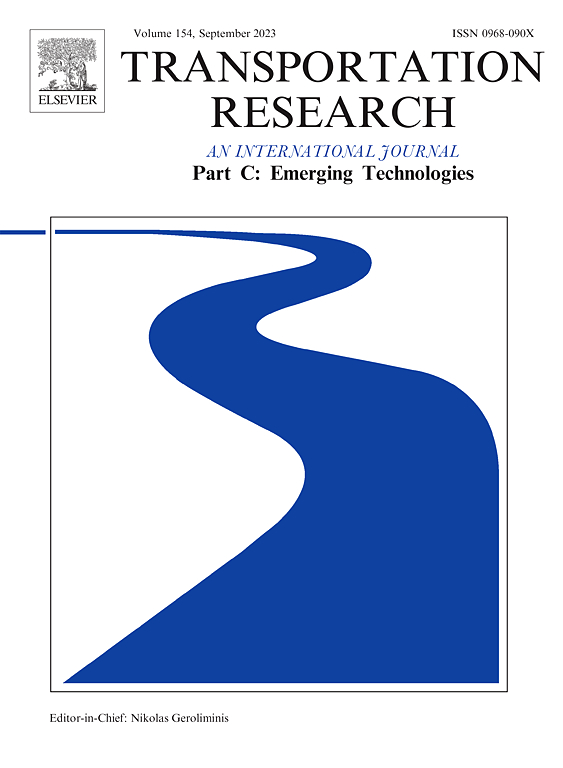考虑供需相互作用的城郊新线票价制度选择与线路规划
IF 7.6
1区 工程技术
Q1 TRANSPORTATION SCIENCE & TECHNOLOGY
Transportation Research Part C-Emerging Technologies
Pub Date : 2025-07-05
DOI:10.1016/j.trc.2025.105240
引用次数: 0
摘要
对于新建的城郊铁路线路,缺乏历史客流数据给线路规划设计和选择合适的收费系统带来了重大挑战。为了解决这个问题,我们使用最小二乘程序来估计重力模型和多项式模型,该模型利用地理数据、社会经济数据、历史客流和列车运行数据,捕捉了与新线相同地区现有铁路网的乘客需求和供给因素之间的相互作用。然后利用这些模型来捕捉新的郊区铁路线的需求和供应之间的相互依赖性。考虑出行时间和票价对乘客需求的影响,提出了一种综合线路规划优化框架,采用重力模型或多项式模型进行需求估计,以优化线路规划和票价系统选择。在本研究中,估计重力和多项式模型将需求表示为广义旅行时间和票价的函数,这些因素与线路规划和票价系统选择决策密切相关。这使得线路规划优化模型能够灵活考虑新建铁路走廊实施不同线路设置和不同票价系统配置的情况,同时还可以评估特定策略属性对需求产生的贡献,同时解决需求分配问题。该方法已经在上海的城市和郊区线路上进行了测试。研究人员利用整个上海地铁网络的历史数据来分析需求和供给之间的相互依赖关系,然后将其应用于两条新线路——上海嘉定-闵行线和机场连接线——以辅助线路设置和票价系统选择的决策。计算结果表明,同时考虑供给侧和需求侧因素后,需求估计的精度显著提高。此外,将这些供需关系嵌入到线路规划优化模型中,大大提高了列车运营解决方案平衡乘客需求和运力供应的能力。本文章由计算机程序翻译,如有差异,请以英文原文为准。
Fare system selection and line planning for new suburban rail lines considering the supply–demand interactions
For newly constructed suburban railway lines, the lack of historical passenger flow data presents a significant challenge in designing line plans and selecting an appropriate fare system. To address this issue, a least-squares procedure is employed to estimate both a gravity model and a polynomial model, which capture the interaction between passenger demand and supply factors for the existing railway network in the same region as the new lines, using geographic data, socioeconomic data, historical passenger flow, and train operation data. These models are then utilized to capture the interdependencies between demand and supply for the new suburban railway lines. An integrated line planning optimization framework is proposed that incorporates either the gravity or polynomial model for demand estimation to optimize line plan and fare system selection considering the impact of travel time and ticket costs on passenger demand. In this study, the estimated gravity and polynomial models express demand as a function of generalized travel time and ticket costs, these factors are closely tied to both line planning and fare system selection decisions. This enables the line planning optimization model to flexibly consider scenarios where newly constructed railway corridors implement different line-setting and different fare system configurations, while also evaluating the contribution of specific strategy attributes to demand generation and simultaneously addressing demand allocation. The proposed method has been tested using Shanghai’s urban and suburban lines. Historical data from the entire Shanghai subway network were used to analyze the interdependencies between demand and supply, which were then applied to two new lines – the Shanghai Jiading–Minhang Line and the Airport Link Line – to assist decision-making regarding line setting and fare system selection. The computational results indicate that the accuracy of demand estimation has significantly improved by incorporating both supply-side and demand-side factors. Additionally, embedding these demand–supply interdependencies into the line planning optimization model has greatly enhanced the ability of train operation solutions to balance passenger demand with capacity supply.
求助全文
通过发布文献求助,成功后即可免费获取论文全文。
去求助
来源期刊
CiteScore
15.80
自引率
12.00%
发文量
332
审稿时长
64 days
期刊介绍:
Transportation Research: Part C (TR_C) is dedicated to showcasing high-quality, scholarly research that delves into the development, applications, and implications of transportation systems and emerging technologies. Our focus lies not solely on individual technologies, but rather on their broader implications for the planning, design, operation, control, maintenance, and rehabilitation of transportation systems, services, and components. In essence, the intellectual core of the journal revolves around the transportation aspect rather than the technology itself. We actively encourage the integration of quantitative methods from diverse fields such as operations research, control systems, complex networks, computer science, and artificial intelligence. Join us in exploring the intersection of transportation systems and emerging technologies to drive innovation and progress in the field.

 求助内容:
求助内容: 应助结果提醒方式:
应助结果提醒方式:


